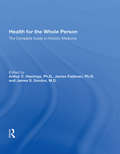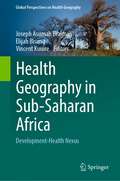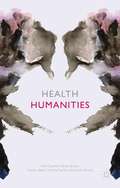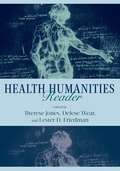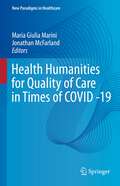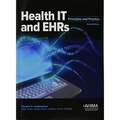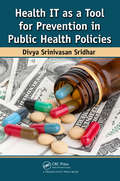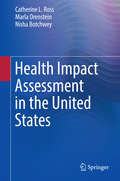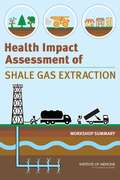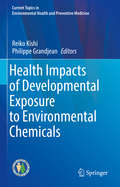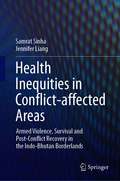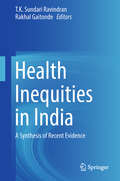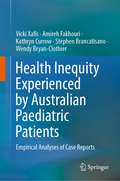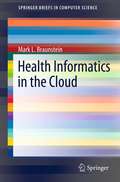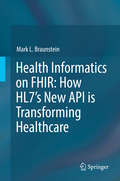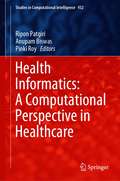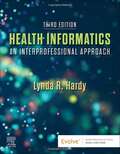- Table View
- List View
Health For The Whole Person: The Complete Guide To Holistic Medicine
by James Fadiman Arthur C. Hastings James S. GordonThis book presents attitudes, information, and tools for a holistic approach to medicine, health, and mental health. In our discussions among ourselves and with the contributing authors we defined three aspects of a holistic approach. First, such an approach involves expanding our focus to include the many personal, familial, social, and environmental factors that promote health, prevent illness, and encourage healing. Second, a holistic approach views the patient as an individual person, not as a symptom-bearing organism. This attitude emphasizes the self-responsibility of the person for his or her health and the importance of mobilizing the person's own health capacities, rather than treating illness only from the outside. Third, the holistic approach tries to make wise use of the many diagnostic, treatment, and health modalities that are available in addition to the standard materia medica- including alternative medical and healing systems as well as psychological techniques and physical modalities. Some of these methods of treatment and health practices are already accepted, others are accepted but not applied in practice, and still others need further research to explore the range of their uses.
Health Geography in Sub-Saharan Africa: Development-Health Nexus (Global Perspectives on Health Geography)
by Joseph Asumah Braimah Elijah Bisung Vincent KuuireThis volume creates a platform to showcase health geography research from countries in sub-Saharan Africa (SSA), and draws on theoretical and methodological innovations to initiate a discussion on the complexities of the issues impacting health in the region. Through theoretically and empirically grounded contributions from a variety of researchers working across SSA, the book addresses a wide range of topics that are usually treated separately when discussing health geography in the region. By bridging the social science and health disciplines, the book introduces new ways of thinking temporally and spatially about these topics in non-geography contexts as well. In 4 sections, the text will broadly appeal to students, researchers, teachers, policy makers, and global health professionals. Section 1 addresses the social determinants of health, including gender, disability, and other inequities and inequalities associated with healthcare access. Section 2 discusses the environmental determinants of health such as food security, water and sanitation, mining, and climate change. Section 3 focuses on current and emerging challenges to health in SSA, including ageing, non-communicable disease, and infectious diseases. Section 4 concludes the text by discussing the need to develop social and environmental intervention policies and strategies to address health challenges in SSA.
Health Humanities
by Paul CrawfordHealth Humanities draws upon the multiple and expanding fields of enquiry that link health and social care disciplines with the arts and humanities. It aims to encourage innovation and novel cross-disciplinary explorations of how the arts and humanities can inform and transform healthcare, health and well-being. It calls for a much richer body of work that breaks out of limited applications of the arts and humanities to any specific healthcare discipline, as in the medical humanities, which to date has been largely preoccupied with training medical practitioners. The health humanities is all about advancing health and well-being through the arts and humanities in ways that are not solely the preserve of medicine or to be defined and driven by it. As a more inclusive and applied field of activity with a fast-growing international community of researchers, health humanities looks to generate diverse and even radical approaches for creating healthier and more compassionate societies. This book aims to assist readers to consider how the arts and humanities can be applied more ambitiously in generating a healthier world.
Health Humanities
by Paul CrawfordThis is the first manifesto for Health Humanities worldwide. It sets out the context for this emergent and innovative field which extends beyond Medical Humanities to advance the inclusion and impact of the arts and humanities in healthcare, health and well-being.
Health Humanities Reader
by Mark Vonnegut Audrey Shafer Martha Stoddard Holmes Howard Brody Jeff Nisker Bradley Lewis Rosemarie Tong Ian Williams Sander L. Gilman Rafael Campo Daniel Goldberg Michael Rowe Thomas R. Cole Alice Dreger Joseph N. Straus Jonathan M. Metzl Arthur W. Frank E. Ann Kaplan Rebecca Hester John Lantos Shelley Wall Alan Bleakley Marjorie Levine-Clark Michael Sappol Mark Clark Professor Therese Jones Professor Delese Wear Professor Lester D. Friedman David H. Flood Rhonda L. Soricelli Lisa Keränen Martin F. Norden Professor Lisa I. Iezzoni Felicia Cohn Martha Montello Amy Haddad Rebecca Garden Jack Coulehan Professor Bernice Hausman Gretchen A. Case Allen Peterkin Susan M. Squier Sayantani DasGupta Maren Grainger-Monsen Benjamin Saxton Jerald Winakur Anne Hudson Jones Tod Chambers Raymond C. Barfield Lucy Selman Jeffrey P. Bishop Catherine Belling Paul Root Wolpe Professor Allison B. Kavey Julie M. Aultman Michael Blackie Erin Gentry Lamb Jay BaruchOver the past forty years, the health humanities, previously called the medical humanities, has emerged as one of the most exciting fields for interdisciplinary scholarship, advancing humanistic inquiry into bioethics, human rights, health care, and the uses of technology. It has also helped inspire medical practitioners to engage in deeper reflection about the human elements of their practice.In Health Humanities Reader, editors Therese Jones, Delese Wear, and Lester D. Friedman have assembled fifty-four leading scholars, educators, artists, and clinicians to survey the rich body of work that has already emerged from the field—and to imagine fresh approaches to the health humanities in these original essays. The collection’s contributors reflect the extraordinary diversity of the field, including scholars from the disciplines of disability studies, history, literature, nursing, religion, narrative medicine, philosophy, bioethics, medicine, and the social sciences. With warmth and humor, critical acumen and ethical insight, Health Humanities Reader truly humanizes the field of medicine. Its accessible language and broad scope offers something for everyone from the experienced medical professional to a reader interested in health and illness.
Health Humanities for Quality of Care in Times of COVID -19 (New Paradigms in Healthcare)
by Maria Giulia Marini Jonathan McFarlandThe Covid pandemic has led us into an upheaval that has made us question the certainties underlying what it means to be a human being in our age; the ability to control medical and social facts through evidence. For the first-time western and developed countries have had to confront what many populations from the developing world (Africa. Latin America, etc) face on a daily basis with HIV and Ebola, etc. The Interconnectedness of Globalization has been the real disseminating catalyst of COVID 19, and many scientists wonder if this virus is the result of the Anthropocene age, with its indisputable lack of respect for the natural ecosystems. The virus has demonstrated that our frailty is only skin deep, and it has not only brought death, despair, but it has broken our interdependency as human beings, by imposing self- isolation as well as creating new ways of connections so that safety cannot imply loneliness. In this book, the coping strategies that originate from the multiple languages of care such as narrative, literature, science, philosophy, art, digital science are shown not only as reflective tools to promote health but also wellbeing amongst carers, patients, students, and citizens of our planet Earth. These strategies should be supported by the decision makers since they are low-cost investments necessary to make the health care system work. They however require a change of cultural paradigm. This book is a useful toolkit for patients, citizens and care services physicians who want to learn more on how to live better with this new world.
Health IT and EHRs: Principles and Practice
by Margret K. AmatayakulThis sixth edition is being renamed Health IT and EHRs as a result of the expanded scope of the technology needed for all health information collection and use. The sixth edition is also focused more on serving as a textbook in addition to serving as a reference work for readers who work in any health setting, whether a healthcare provider organization, vendor, health plan, or policy-maker. The book introduces the full scope of health IT in chronological fashion, covering the information systems development life cycle, strategic planning, goal setting workflow and process mapping, change management, vendor selection, project management, and implementation, training, and ongoing maintenance of EHR and other health IT systems. It also addresses the essential elements of data infrastructure, information technology, privacy and security, and interoperability for all forms of health IT. Finally, there is considerable expansion in chapters covering techniques to achieve value with health IT in various acute care, ambulatory care, and specialty care settings as well as for consumer health IT, enterprise content and record management as an EHR bridge technology, revenue cycle management, and population health. Those familiar with the fifth edition of Electronic Health Records: A Practical Guide for Professionals and Organizations will find that some of the chapters have been moved around, consolidated, or expanded in the sixth edition. Two chapters have been added, on revenue cycle management and population health, given expanded interest in integrating information on clinical, administrative or financial, and social determinants of health.
Health IT and Patient Safety: Building Safer Systems for Better Care
by Committee on Patient Safety Health Information TechnologyIOM's 1999 landmark study To Err is Human estimated that between 44,000 and 98,000 lives are lost every year due to medical errors. This call to action has led to a number of efforts to reduce errors and provide safe and effective health care. Information technology (IT) has been identified as a way to enhance the safety and effectiveness of care. In an effort to catalyze its implementation, the U. S. government has invested billions of dollars toward the development and meaningful use of effective health IT. Designed and properly applied, health IT can be a positive transformative force for delivering safe health care, particularly with computerized prescribing and medication safety. However, if it is designed and applied inappropriately, health IT can add an additional layer of complexity to the already complex delivery of health care. Poorly designed IT can introduce risks that may lead to unsafe conditions, serious injury, or even death. Poor human-computer interactions could result in wrong dosing decisions and wrong diagnoses. Safe implementation of health IT is a complex, dynamic process that requires a shared responsibility between vendors and health care organizations. Health IT and Patient Safety makes recommendations for developing a framework for patient safety and health IT. This book focuses on finding ways to mitigate the risks of health IT-assisted care and identifies areas of concern so that the nation is in a better position to realize the potential benefits of health IT. Health IT and Patient Safety is both comprehensive and specific in terms of recommended options and opportunities for public and private interventions that may improve the safety of care that incorporates the use of health IT. This book will be of interest to the health IT industry, the federal government, healthcare providers and other users of health IT, and patient advocacy groups.
Health IT as a Tool for Prevention in Public Health Policies
by Divya Srinivasan SridharHealth IT as a Tool for Prevention in Public Health Policies examines the current state of Health Information Technology (HIT) in the United States. It investigates the converging problems of chronic disease, societal welfare, childhood obesity, and the lack of healthcare for the economically disadvantaged in the U.S. It considers various providers
Health Impact Assessment in the United States
by Catherine L. Ross Marla Orenstein Nisha BotchweyA new public policy initiative is proposed, or a large-scale construction project. What is its potential impact on the health of the population? Are there adverse effects to address, health benefits to be promoted, some combination of both? A Health Impact Assessment (HIA) is a cross-disciplinary means of answering these and other complex questions, so programs, projects, or policies can be adjusted accordingly. Health Impact Assessment in the United States analyzes the goals, tools, and methods of HIA, and the competencies that are central to establishing best practices. It sets out the core principles that differentiate HIA from environmental and similar assessments, fleshing them out with case examples from the U. S. and abroad. Details of each step of the HIA process take follow-through into account, giving readers insights into not only collecting and evaluating data, but also communicating findings effectively to decision-makers and stakeholders. The book's expert coverage includes: The importance of HIA to policy development. Introduction to public health, community planning, and health assessment. Overview of the core concepts of HIA, with illustrative examples. Step-by-step guide to conducting an HIA, from screening to evaluation. Emerging technologies shaping HIA tools and procedures. Appendices featuring sample assessment sections and other resources. The HIA has an increasingly vital place in the future of health-related policy, making Health Impact Assessment in the United States a valued manual and critical ideabook for students and practitioners in public health, public policy, urban planning, and community planning. "This book charts the growth of HIA in the United States, and provides invaluable guidance on conducting HIAs and utilizing their results. Very highly recommended. " Howard Frumkin, MD, DrPH, Dean, University of Washington School of Public Health "This new book by three internationally recognized leaders in the field provides a practical guide to using this tool to identify important but often unrecognized opportunities and risks for health created by decisions in transportation, housing, energy, and other sectors. " Aaron Wernham, Director of the Health Impact Project, a collaboration of the Robert Wood Johnson Foundation and The Pew Charitable Trusts. "This book makes an important contribution to the health impact assessment field and is a great resource for practitioners, researchers and students. . . it helps the reader to not only understand HIA but to do it. " Ben Harris-Roxas, Conjoint Lecturer, Centre for Primary Health Care and Equity, University of New South Wales; Health Section Co‐Chair, International Association for Impact Assessment; Consultant, Harris‐Roxas Health. "Health Impact Assessment in the United States is an important resource. . . helping to uncover hidden causes of health inequities in proposals and identifying potential solutions before the proposals are implemented. " Angela Glover Blackwell, Founder and CEO, PolicyLink
Health Impact Assessment of Shale Gas Extraction: Workshop Summary
by Christine CoussensNatural gas extraction from shale formations, which includes hydraulic fracturing, is increasingly in the news as the use of extraction technologies has expanded, rural communities have been transformed seemingly overnight, public awareness has increased, and regulations have been developed. The governmental public health system, which retains primary responsibility for health, was not an early participant in discussions about shale gas extraction; thus public health is lacking critical information about environmental health impacts of these technologies and is limited in its ability to address concerns raised by regulators at the federal and state levels, communities, and workers employed in the shale gas extraction industry. "Health Impact Assessment of Shale Gas Extraction" is the summary of a workshop convened in 2012 by the Institute of Medicine (IOM) Roundtable on Environmental Health Sciences, Research, and Medicine to discuss the human health impact of shale gas extraction through the lens of a health impact assessment. Eminent scientists, physicians, public health experts, and representatives from government agencies at federal and state levels, from nongovernment organizations, from the business sector, and from interest groups representing the interests of the citizens met to exchange ideas and to inform on hydraulic fracturing as a means of extraction of natural gas. This report examines the state of the science regarding shale gas extraction, the direct and indirect environmental health impacts of shale gas extraction, and the use of health impact assessment as a tool that can help decision makers identify the public health consequences of shale gas extraction.
Health Impacts of Developmental Exposure to Environmental Chemicals (Current Topics in Environmental Health and Preventive Medicine)
by Reiko Kishi Philippe GrandjeanThis book provides concise and cutting-edge studies on threats resulting from exposure to environmental chemicals that can affect human health and development, with a particular emphasis on the DOHaD concept. The book is divided into five main parts, the first of which includes an introduction to the impacts of developmental exposure to environmental chemicals and historical perspectives, while the second focuses on how environmental chemicals can affect human organs, including neurodevelopment, immune functions, etc. In turn, the third part addresses the characteristics of specific chemicals and their effects on human health and development, while the fourth part provides a basis for future studies by highlighting the latest innovations in toxicology, remaining challenges, and promising strategies in children’s environmental health research, as well as ideas on how to bridge the gap between research evidence and practical policymaking. The fifth and last part outlines further research directions and related policymaking aspects. Health Impacts of Developmental Exposure to Environmental Chemicals will appeal to young and veteran researchers, students, and physicians (especially gynecologists and pediatricians) who are seeking comprehensive information on how children’s health can be affected by harmful chemicals and other environmental toxicants.
Health Inequalities: From Titanic to the Crash
by Danny DorlingThe third digital-only ebook taster of Unequal health: The scandal of our times by Danny Dorling. Competitively priced, it gives a flavour of one of the major themes: health inequalities and contains three chapters from the book, preceded by an all-new introduction specially written by Danny Dorling. This ‘must-read’ will introduce an even wider readership to his work.
Health Inequality and Development
by David Lawson Mark Mcgillivray Indranil DuttaThis book investigates issues related to health inequality with a particular interest on developing countries. It provides rigorous empirical work on both trends and causal factors behind health inequality, analyzes the implications of health deprivations on poverty traps and suggests practical policies which can be implemented.
Health Inequality: An Introduction to Concepts, Theories and Methods
by Mel Bartley Michelle Kelly-IrvingThe persistence of stark health inequalities in today’s world is painfully clear to see, not least in the effects of the Covid-19 pandemic and falling life expectancy in many parts of the world. How can we advance our understanding of the full extent of health inequality, what drives it, and ways to address it? The third edition of this popular book closely examines the influence of social class, gender, and race/ethnicity (among other issues) on health in the light of broad macro-political contexts. The classic behavioural, psychosocial, and material approaches to health and their embodiment within a life-course perspective are introduced but, importantly, are also re-situated within the growing understanding of the commercial and political determinants of health. Bartley and Kelly-Irving draw on extensive new evidence that shows how the chances for everyone to lead a long and healthy life depend on where power lies to control health-damaging policies and introduce health-promoting ones. Health Inequality will continue to be essential reading for students taking courses in the sociology of health and illness, social policy and welfare, health sciences, public health and epidemiology and all those interested in understanding the consequences of social inequality for health.
Health Inequities in Conflict-affected Areas: Armed Violence, Survival and Post-Conflict Recovery in the Indo-Bhutan Borderlands
by Samrat Sinha Jennifer LiangThis book provides an insight into the issue of health inequity brought about by the violent conflict in Northeast India. While examining the deep vulnerabilities and loss of well-being suffered by families displaced by conflict in the Indo-Bhutan borderland region, the authors raise fundamental questions of accountability and the role of various stakeholders in providing humanitarian assistance to those affected by the conflict. It highlights for the reader the role played by conflict and armed violence in dismantling a functioning public health system and delineates the long-term barriers to post-conflict recovery. The book is written by those who have worked in implementing development and peacebuilding programs in the Bodoland Territorial Region (BTR) of Western Assam. The book especially brings to the fore the voices of those communities directly affected by conflict in Bodoland. The book is valuable to researchers, development practioners and policy makers. Given the unique format of the book, which includes a number of case studies, it is particularly useful for students of development, public health and allied disciplines such as international relations as well as peace and conflict studies.
Health Inequities in India
by T. K. Sundari Ravindran Rakhal GaitondeThis timely contribution to the global literature on health inequities approaches the subject through a synthesis and analysis of relevant published literature on India. Amongst the BRICS countries, India ranks the lowest in the gender-gap index and has the highest poverty rate, and there is clear evidence that socio-economic inequalities have increased in India in the twenty-first century. These have direct impact on the health conditions of its peop≤ however, there has been relatively little concerted research attention on health inequities in India. This volume fills the gap by synthesizing research evidence since the year 2000 on the topic. This is perhaps the first volume on this topic of such scope and breadth. Its uniqueness lies in the synthesis of evidence across a range of axes of disadvantages within a single volume: socio-economic position, caste, gender, other socially constructed vulnerabilities such as disability, HIV status, migrant status; and health-system factors contributing to or mitigating inequities in health. Each core chapter not only summarizes research findings but also engages critically with the perspectives reflected in the chapters and proposes a framework for understanding the mechanisms through which health inequities result. This volume highlights and addresses research gaps in both methodology and content, and is valuable to researchers and students of public health and allied health disciplines, including the social sciences, and also to policy makers and donors.
Health Inequity Experienced by Australian Paediatric Patients: Empirical Analyses of Case Reports
by Vicki Xafis Amireh Fakhouri Kathryn Currow Stephen Brancatisano Wendy Bryan-ClothierThis book provides rare insight into how real children/adolescents’ lives unfold as a result of health inequity. The authors present the findings of empirical research into the health and social circumstances of 61 Australian children/adolescents, as reported by healthcare professionals who attended to their medical needs, revealing how healthcare professionals deal with health inequity on the ground. Profound inequities in the health and wellbeing of children/adolescents worldwide have been the focus of intense research for decades. The extent to which children/adolescents’ health and wellbeing is impacted by violence, poverty, their inability to access integrated healthcare services, parental and adolescent substance abuse, unemployment, poor living conditions, poor nutrition, a fractured social support network, disrupted education, and lack of transportation, is widely recognized. While essential, statistical analyses alone cannot reveal the faces of those experiencing health inequity. This work highlights the need for urgent coordinated action to address health inequity so that children and young people have a chance to lead a full life in good health. It is relevant to researchers and practitioners whose work relates to improving children and young people’s lives.“This book should be required reading for those who influence policies developed by all the sectors mentioned above and their funding and administrative bodies – and politicians in particular” (Anonymous Reviewer).
Health Informatics Data Analysis
by Dong Xu Fengfeng Zhou May D. Wang Yunpeng CaiThis book provides a comprehensive overview of different biomedical data types, including both clinical and genomic data. Thorough explanations enable readers to explore key topics ranging from electrocardiograms to Big Data health mining and EEG analysis techniques. Each chapter offers a summary of the field and a sample analysis. Also covered are telehealth infrastructure, healthcare information association rules, methods for mass spectrometry imaging, environmental biodiversity, and the global nonlinear fitness function for protein structures. Diseases are addressed in chapters on functional annotation of lncRNAs in human disease, metabolomics characterization of human diseases, disease risk factors using SNP data and Bayesian methods, and imaging informatics for diagnostic imaging marker selection. With the exploding accumulation of Electronic Health Records (EHRs), there is an urgent need for computer-aided analysis of heterogeneous biomedical datasets. Biomedical data is notorious for its diversified scales, dimensions, and volumes, and requires interdisciplinary technologies for visual illustration and digital characterization. Various computer programs and servers have been developed for these purposes by both theoreticians and engineers. This book is an essential reference for investigating the tools available for analyzing heterogeneous biomedical data. It is designed for professionals, researchers, and practitioners in biomedical engineering, diagnostics, medical electronics, and related industries.
Health Informatics in the Cloud
by Mark L. BraunsteinDespite its high cost, the US healthcare system produces relatively short life spans, and is wasteful, inefficient and has serious safety and quality issues. While other industries have surmounted similar challenges by transforming themselves through information technology, healthcare lags behind. Major reasons are that our approaches to care delivery and financial incentives were designed for a bygone era. Beyond that the technology offered to practitioners has often been overly expensive, poorly designed, overly proprietary, hard to implement and difficult to use. Spurred by a unique, one-time Federal stimulus and the new mobile, wireless and cloud technologies now available, this landscape is rapidly changing. To succeed going forward practitioners, and those interested in entering the field, need to understand the new driving forces and have a basic understanding of contemporary clinical informatics. Practitioners, in particular, need to understand the alternative technologies and approaches available for their use in individual patient care and more continuous management of their chronic disease patients. To efficiently meet these needs, this book provides an introduction to the rationale for care transformation through clinical informatics; its application to patient care outside of hospitals; and a look at its future. Key points are illustrated throughout by actual examples of open source and commercial health IT products and services. While written with practitioners and students entering the field of clinical informatics in mind, the book eschews technical terminology and is easily accessible by the lay reader not proficient in clinical medicine or information technology.
Health Informatics on FHIR: How HL7's API is Transforming Healthcare (Health Informatics)
by Mark L. BraunsteinThis extensively revised textbook describes and defines the US healthcare delivery system, its many systemic challenges and the prior efforts to develop and deploy informatics tools to help overcome these problems. Now that electronic health record systems are widely deployed, the HL7 Fast Healthcare Interoperability standard is being rapidly accepted as the means to access and share the data stored in those systems and analytics is increasing being used to gain new knowledge from that aggregated clinical data, this book goes on to discuss health informatics from an historical perspective, its current state and likely future state. It then turns to some of the important and evolving areas of informatics including electronic healt\h records, clinical decision support,. population and public health, mHealth and analytics. Numerous use cases and case studies are employed in all of these discussions to help readers connect the technologies to real world challenges. Health Informatics on FHIR: How HL7's API is Transforming Healthcare is for introductory health informatics courses for health sciences students (e.g., doctors, nurses, PhDs), the current health informatics community, computer science and IT professionals interested in learning about the field and practicing healthcare providers. Though this textbook covers an important new technology, it is accessible to non-technical readers including healthcare providers, their patients or anyone interested in the use of healthcare data for improved care, public/population health or research.
Health Informatics on FHIR: How HL7's New API is Transforming Healthcare
by Mark L. BraunsteinThis textbook begins with an introduction to the US healthcare delivery system, its many systemic challenges and the prior efforts to develop and deploy informatics tools to help overcome those problems. It goes on to discuss health informatics from an historical perspective, its current state and its likely future state now that electronic health record systems are widely deployed, the HL7 Fast Healthcare Interoperability standard is being rapidly accepted as the means to access the data stored in those systems and analytics is increasing being used to gain new knowledge from that aggregated clinical data. It then turns to some of the important and evolving areas of informatics including population and public health, mHealth and big data and analytics. Use cases and case studies are used in all of these discussions to help readers connect the technologies to real world challenges. Effective use of informatics systems and tools by providers and their patients is key to improving the quality, safety and cost of healthcare. With health records now digital, no effective means has existed for sharing them with patients, among the multiple providers who may care for them and for important secondary uses such as public/population health and research. This problem is a topic of congressional discussion and is addressed by the 21st Century Cures Act of 2016 that mandates that electronic health record (EHR) systems offer a patient-facing API. HL7’s Fast Healthcare Interoperability Resources (FHIR) is that API and this is the first comprehensive treatment of the technology and the many ways it is already being used. FHIR is based on web technologies and is thus a far more facile, easy to implement approach that is rapidly gaining acceptance. It is also the basis for a ‘universal health app platform’ that literally has the potential to foster innovation around the data in patient records similar to the app ecosystems smartphones created around the data they store. FHIR app stores have already been opened by Epic and Cerner, the two largest enterprise EHR vendors. Provider facing apps are already being explored to improve EHR usability and support personalized medicine. Medicare and the Veteran’s Administration have announced FHIR app platforms for their patients. Apple’s new IOS 11.3 features the ability for consumers to aggregate their health records on their iPhone using FHIR. Health insurance companies are exploring applications of FHIR to improve service and communication with their providers and patients. SureScripts, the national e-Prescribing network, is using FHIR to help doctors know if their patients are complying with prescriptions. This textbook is for introductory health informatics courses for computer science and health sciences students (e.g. doctors, nurses, PhDs), the current health informatics community, IT professionals interested in learning about the field and practicing healthcare providers. Though this textbook covers an important new technology, it is accessible to non-technical readers including healthcare providers, their patients or anyone interested in the use of healthcare data for improved care, public/population health or research.
Health Informatics: A Computational Perspective in Healthcare (Studies in Computational Intelligence #932)
by Ripon Patgiri Anupam Biswas Pinki RoyThis book presents innovative research works to demonstrate the potential and the advancements of computing approaches to utilize healthcare centric and medical datasets in solving complex healthcare problems. Computing technique is one of the key technologies that are being currently used to perform medical diagnostics in the healthcare domain, thanks to the abundance of medical data being generated and collected. Nowadays, medical data is available in many different forms like MRI images, CT scan images, EHR data, test reports, histopathological data and doctor patient conversation data. This opens up huge opportunities for the application of computing techniques, to derive data-driven models that can be of very high utility, in terms of providing effective treatment to patients. Moreover, machine learning algorithms can uncover hidden patterns and relationships present in medical datasets, which are too complex to uncover, if a data-driven approach is not taken. With the help of computing systems, today, it is possible for researchers to predict an accurate medical diagnosis for new patients, using models built from previous patient data. Apart from automatic diagnostic tasks, computing techniques have also been applied in the process of drug discovery, by which a lot of time and money can be saved. Utilization of genomic data using various computing techniques is another emerging area, which may in fact be the key to fulfilling the dream of personalized medications. Medical prognostics is another area in which machine learning has shown great promise recently, where automatic prognostic models are being built that can predict the progress of the disease, as well as can suggest the potential treatment paths to get ahead of the disease progression.
Health Informatics: A Systems Perspective, Second Edition (AUPHA/HAP Book)
by Gordon BrownInstructor Resources: Authors’ responses to the chapter and case study discussion questions; guidance on how the case studies may be used; PowerPoint slides of the exhibits to supplement classroom discussions and lectures; and suggested activities for exploring chapter topics, including data sets. As the reach and influence of technology grow, the world becomes increasingly connected. What happens in one system—finance, manufacturing, research, infrastructure, supply chain, and many more—can have a significant impact on the activities and outcomes in other systems. Healthcare is no exception. Connecting all of these systems is vital in order to properly support clinical care. Health informatics has the potential to align these interlocking systems in a way that transforms clinical decision-making and healthcare delivery to optimize overall system performance. Health Informatics: A Systems Perspective takes a systems approach to leveraging information in healthcare and enhancing providers’ capabilities through the use of technology and knowledge transfer. The book offers a conceptual framework for aligning clinical decision processes with system infrastructures, including information technology, organizational design, financing, and evaluation. The book’s contributors—all leading academics and healthcare practitioners—balance theoretical viewpoints with practical considerations. Case studies and informative sidebars support theory with real-world applications, while learning objectives, key concepts, and discussion questions facilitate learning and reinforce content. A glossary, which defines the main concepts and key terminologies presented in the text, provides a useful overview of the material. Thoroughly updated and revised, the second edition includes three new chapters on information systems in relation to population health, global health systems, and alternative financial mechanisms and their compatibility with innovative delivery models. Additional topics include:The role of human resources and information technology in healthcareKnowledge-based decision-makingTransforming clinical work processesNursing informaticsPrecision medicineData and information securityAn essential resource for students and practicing managers alike, Health Informatics: A Systems Perspective explains how information technology can enable the transformation of health organizations to improve not only the quality of healthcare, but also the health of individuals and populations.
Health Informatics: An Interprofessional Approach
by Lynda R. HardyHealth Informatics: An Interprofessional Approach, 3rd Edition, follows the tradition of expert informatics educators Ramona Nelson and Nancy Staggers with new lead author, Lynda R. Hardy, to prepare you for success in today’s technology-filled healthcare practice. Concise coverage includes information systems and applications, such as electronic health records, clinical decision support, telehealth, mHealth, ePatients, and social media tools, as well as system implementation. New to this edition are topics that include analytical approaches to health informatics, increased information on FHIR and SMART on FHIR, and the use of health informatics in pandemics.
